
Pimelea microcephala, commonly known as mallee rice-flower or shrubby rice-flower is a species of flowering plant in the family Thymelaeaceae and is endemic to mainland Australia. It is an erect shrub with compact heads of male or female, white to yellow or greenish flowers on separate plants, the heads surrounded by 2 or 4 leaf-like involucral bracts.

Pimelea flava is a species of flowering plant in the family Thymelaeaceae and is endemic to south-eastern Australia. It is a shrub with narrowly elliptic to egg-shaped leaves arranged in opposite pairs, and compact clusters of 9 or more flowers with 2 or 4 elliptic to circular involucral bracts at the base. The flowers and bracts are white or yellow, depending on subspecies.

Pimelea octophylla, commonly known as woolly riceflower or downy riceflower, is a species of flowering plant in the family Thymelaeaceae and is endemic to south-eastern continental Australia. It is an erect shrub with densely hairy young stems, narrowly elliptic leaves and heads of 22 to 45 densely hairy, cream-coloured to pale yellow flowers surrounded by 6 to 12 leaf-like involucral bracts.

Leucopogon juniperinus, commonly known as prickly beard-heath, is a species of flowering plant in the heath family Ericaceae and is endemic to south-eastern continental Australia. It is an erect, densely-branched shrub with oblong to more or less egg-shaped leaves with the narrower end towards the base, and white, tube-shaped flowers arranged singly in upper leaf axils.

Pimelea serpyllifolia, commonly known as thyme riceflower, is a species of flowering plant in the family Thymelaeaceae and is endemic to southern Australia. It is an erect shrub with narrowly elliptic to spatula-shaped leaves, and compact heads of 4 to 12 yellow, yellowish-green or white flowers surrounded by 2 or 4 leaf-like involucral bracts. Male and female flowers are borne on separate plants.

Pimelea ligustrina is a species of flowering plant in the family Thymelaeaceae, and is endemic to south-eastern Australia. It is a shrub with lance-shaped or narrowly elliptic leaves arranged in opposite pairs, and clusters of creamy-white, white or pinkish flowers usually surrounded by 4 or 8, greenish to reddish brown involucral bracts.
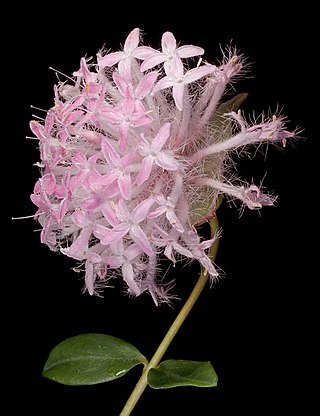
Pimelea hispida, commonly known as bristly pimelea, is a species of flowering plant in the family Thymelaeaceae and is endemic to the southwest of Western Australia. It is an erect shrub with elliptic leaves and erect clusters of pink flowers surrounded by 4 green involucral bracts.

Pimelea glauca, commonly known as smooth riceflower, is a species of flowering plant in the family Thymelaeaceae and is endemic to eastern Australia. It has elliptic to more or less lance-shaped or linear leaves and creamy-white flowers arranged in heads of seven or more on the ends of the stems, with four lance-shaped to egg-shaped bracts at the base of the inflorescence.
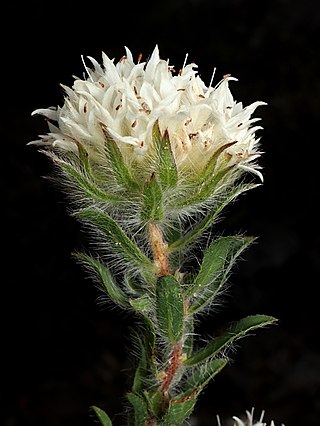
Pimelea imbricata is a species of flowering plant in the family Thymelaeaceae and is native to the southwest of Western Australia and south-eastern South Australia. It is a shrub with narrowly elliptic leaves and erect, compact clusters of white or pink flowers surrounded by 10 to 22 green or red to purple involucral bracts.
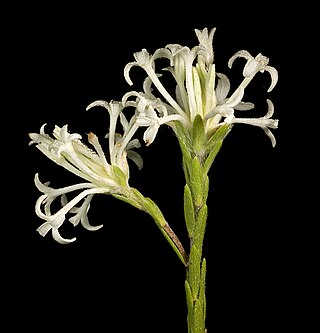
Pimelea longiflora is a species of flowering plant in the family Thymelaeaceae and is endemic to the southwest of Western Australia. It is an erect, spindly shrub with linear to narrowly elliptic leaves and erect clusters of white to cream-coloured flowers, surrounded by 4 to 6 green, egg-shaped involucral bracts.
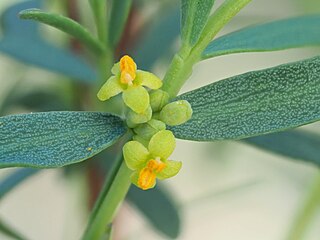
Pimelea pauciflora, commonly known as poison rice-flower, is a species of shrub in the family Thymelaeaceae. It has small yellow-lime flowers and green, smooth fleshy leaves, and is endemic to Eastern Australia.
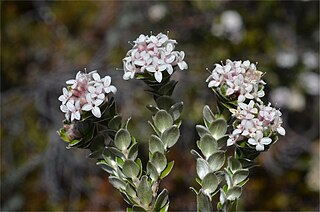
Pimelea sericea is a species of flowering plant in the family Thymelaeaceae and is endemic to Tasmania. It is a shrub with densely hairy young stems, elliptic leaves arranged in opposite pairs, and compact clusters of white, pink or pinkish-white flowers.
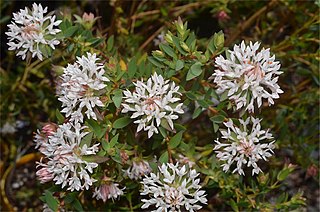
Pimelea sylvestris is a species of flowering plant in the family Thymelaeaceae and is endemic to the south-west of Western Australia. It is an erect shrub with narrowly elliptic to elliptic leaves arranged in opposite pairs, and compact heads of white or pink flowers surrounded by 2 or 4 pairs of narrowly egg-shaped involucral bracts.

Pimelea curviflora, also known as curved rice-flower, is a shrub in the family Thymelaeaceae and is endemic to Australia. It is a small, hairy shrub with greenish-yellow or red tubular flowers.

Goodenia humilis, commonly known as swamp goodenia, is a species of flowering plant in the family Goodeniaceae and is endemic to south-eastern Australia. It is a weak, perennial herb with linear to lance-shaped leaves mostly at the base of the plant, and racemes or thyrses of yellow or yellowish-brown flowers.

Leucopogon appressus is a species of flowering plant in the heath family Ericaceae and is endemic to south-eastern New South Wales. It is a small, spreading to erect shrub with wiry stems, lance-shaped or narrowly egg-shaped to elliptic leaves and small white flowers.

Epacris paludosa, commonly known as swamp heath, is a species of flowering plant from the heath family, Ericaceae, and is endemic to eastern Australia. It is an erect, bushy shrub with lance-shaped, elliptic or egg-shaped leaves and tube-shaped white or cream-coloured flowers in crowded, leafy heads at the ends of branches.

Pimelea argentea, commonly known as silvery leaved pimelea, is a species of flowering plant in the family Thymelaeaceae and is endemic to the south-west of Western Australia. It is an erect shrub with densely hairy young stems and leaves, the leaves linear to elliptic, and heads of white to yellow or greenish flowers, the male and female flowers on separate plants.
Pimelea lanata is a species of flowering plant in the family Thymelaeaceae and is endemic to the southwest of Western Australia. It is a shrub with narrowly elliptic leaves and erect clusters of white to deep pink flowers surrounded by 4, mostly green, involucral bracts.

Pimelea latifolia is a species of flowering plant in the family Thymelaeaceae and is endemic to eastern Australia. It is a shrub with hairy young stems, egg-shaped leaves with the narrower end towards the base, and greenish-yellow to white, tube-shaped flowers.




















